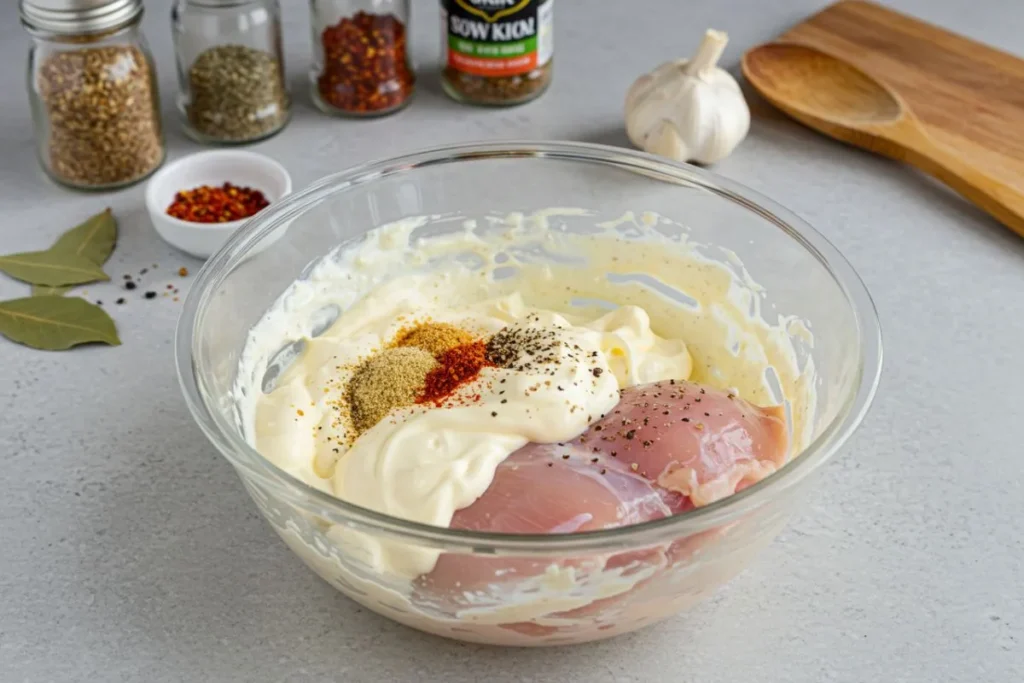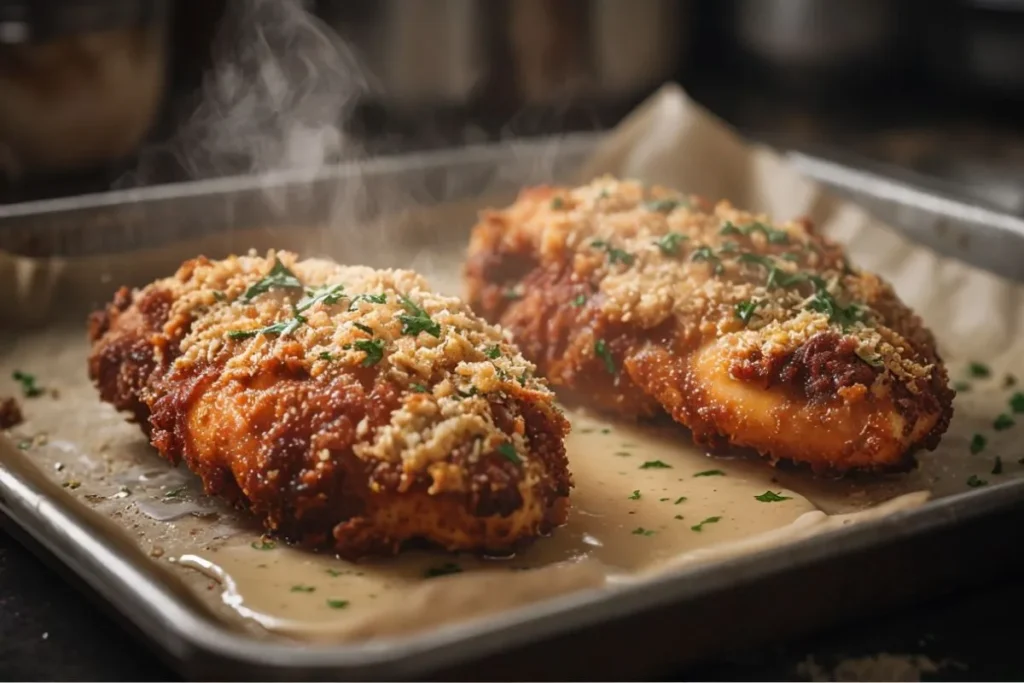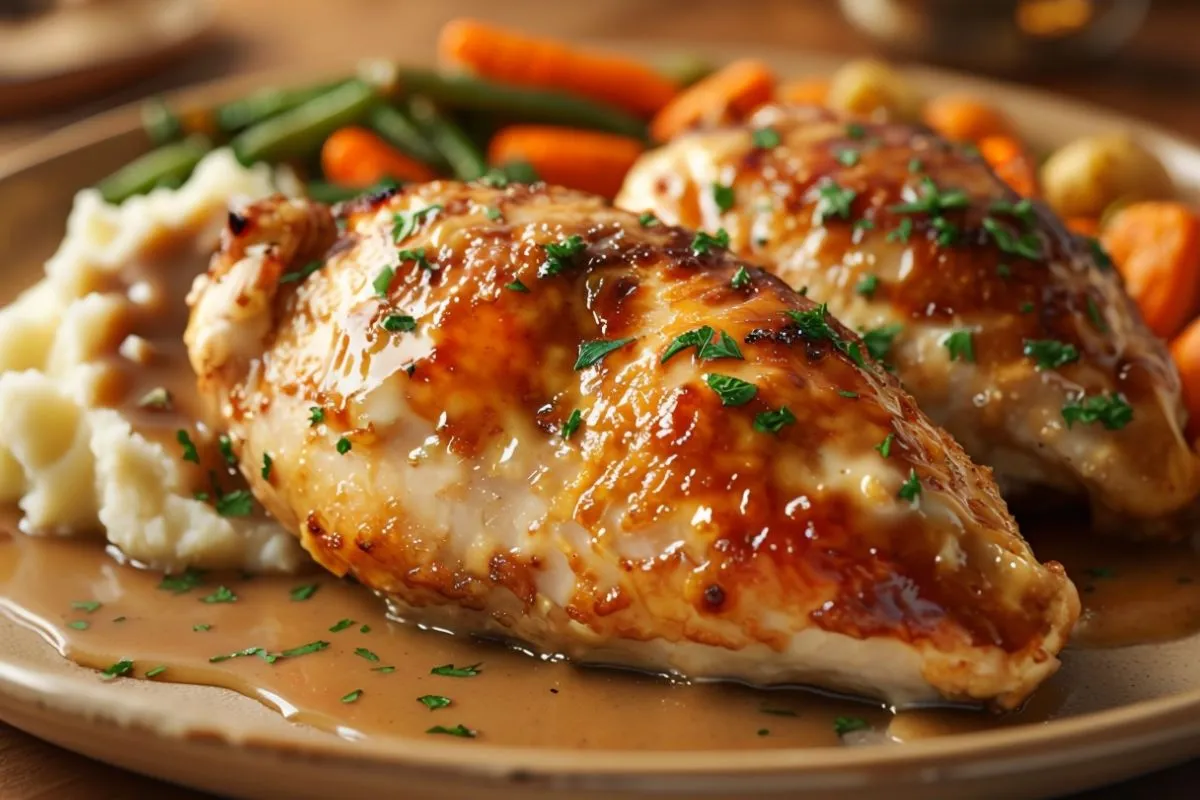Cooking chicken that’s tender, flavorful, and downright irresistible isn’t always easy. But one kitchen hack has gained quite the reputation for delivering juicy, melt-in-your-mouth results: mayonnaise. You might be wondering, “Why do people put mayonnaise on chicken before cooking?” It’s not just a quirky trend—it’s backed by science and culinary know-how.
In this article, we’ll explore the magic of mayonnaise in the kitchen. From its unique composition to the incredible benefits it offers for chicken recipes, you’ll discover why this creamy condiment deserves a spot in your next dish. Whether you’re a home cook looking to elevate your meals or just curious about this technique, we’ve got you covered.
Introduction to Using Mayonnaise in Cooking
Why Mayonnaise?
Mayonnaise might seem like an odd choice for cooking, but it’s incredibly useful in the kitchen. Packed with oil, egg yolk, and vinegar, this creamy mixture does more than just add flavor. It softens the meat, boosts taste, and even acts as a shield during cooking.
Many cooks swear by it because it’s versatile and easy to use. Unlike marinades that require hours to work their magic, mayonnaise delivers results in a fraction of the time. Its thick consistency clings to the chicken, ensuring an even coating that locks in moisture.
Key Takeaway
Using mayonnaise when cooking chicken is a big improvement. It’s not just about making things easier; it’s about getting amazing results with little effort. The rest of this article will explore the science, benefits, and techniques behind this surprisingly effective method.
The Science Behind Mayonnaise and Tender Chicken
What is Mayonnaise Made Of?
Mayonnaise is a simple mixture of oil, egg yolks, vinegar, or lemon juice, creating a creamy, all-purpose condiment. The high fat content from oil is the secret behind its ability to soften the chicken and keep it moist. Egg yolks act as a glue, helping the mayonnaise stick to the meat evenly, while the acidity breaks down proteins, making the chicken tender.
Interestingly, the science doesn’t stop there. Mayonnaise also forms a protective barrier on the chicken’s surface, reducing moisture loss during cooking. This is why dishes like melt-in-your-mouth chicken shine when mayonnaise is involved—moisture stays locked in, and the chicken emerges tender and juicy.
How Does It Work?
When applied to chicken, mayonnaise works as both a marinade and a coating. Its fat content coats the meat fibers, keeping them moist even under high heat. Additionally, the vinegar or lemon juice helps break down proteins, making the chicken softer.
Moreover, the mixture creates an even cooking surface, ensuring that the chicken cooks evenly without drying out. Pair this with the right cooking method, like baking, and you have an easy way to get perfect results.
For an example of a dish that uses mayonnaise effectively, check out this Melt-in-Your-Mouth Chicken Recipe.
Benefits of Using Mayonnaise in Cooking
Tenderizing Properties
One of the main reasons people put mayonnaise on chicken before cooking is its amazing ability to tenderize meat. The high-fat content in mayonnaise coats the chicken evenly, while its acidity helps break down proteins. This results in chicken that’s incredibly soft and juicy.
Unlike marinades that can take hours to work, mayonnaise starts tenderizing almost instantly. This makes it perfect for quick meals when you don’t have much time to prep. For instance, a simple mix of mayonnaise with a pinch of garlic powder and smoked paprika can create a quick, flavorful marinade for chicken breasts.
Additionally, mayonnaise works particularly well with lean cuts like chicken breasts, which are prone to drying out. The protective coating ensures the meat retains its natural juices, even when cooked at high temperatures. If you’re cooking chicken thighs or drumsticks, mayonnaise adds an extra layer of richness, making every bite juicy.
Fats, like those found in mayonnaise, play a key role in keeping chicken moist and flavorful. To learn more about the benefits of fats in a balanced diet, visit the Mayo Clinic’s guide to nutrition.
Flavor Enhancements
Mayonnaise isn’t just about texture; it’s also a flavor powerhouse. Its rich, creamy base acts as a canvas, allowing you to customize the taste to your liking. For example, you can mix mayonnaise with Dijon mustard, fresh herbs like rosemary, or even grated Parmesan cheese to create unique flavor combinations.
Moreover, mayonnaise brings out the natural flavors of chicken. As it cooks, the fats in the mayonnaise mix with the chicken juices, creating a rich, savory taste that’s hard to copy with other marinades. This is why dishes like melt-in-your-mouth chicken stand out—they’re full of flavor in every bite.
If you’re feeling adventurous, you can experiment with bold spices like curry powder, chili flakes, or cumin. These additions not only enhance the dish but also give it a distinctive twist, making it suitable for a variety of cuisines.
Golden Crust
Another reason people use mayonnaise on chicken is its ability to create a beautiful, golden crust. When exposed to heat, the oil in mayonnaise caramelizes, giving the chicken a crispy, golden-brown exterior. This effect is especially clear when baking or broiling, where the heat evenly distributes over the chicken.
To achieve this, all you need to do is spread a thin layer of mayonnaise over the chicken before cooking. For an extra crunch, sprinkle breadcrumbs on top. As the mayonnaise cooks, it binds the breadcrumbs to the chicken, resulting in a crispy, flavorful coating.
Compared to traditional breading methods, mayonnaise is much easier to work with. It removes the need for multiple steps like dipping the chicken in flour or eggs. Plus, it ensures the coating sticks evenly, making the final dish look as good as it tastes.
Comparison to Other Marinades
While marinades like yogurt, buttermilk, or olive oil are often used for chicken, mayonnaise offers a unique set of benefits. Yogurt, for example, is great for tenderizing but lacks the fat content needed to lock in moisture as effectively as mayonnaise. Similarly, olive oil provides a light coating but doesn’t create the same rich, creamy flavor profile.
Mayonnaise combines the best of both worlds—it tenderizes, locks in moisture, and enhances flavor all at once. Its many uses make it a favorite ingredient for many home cooks.
Cooking Tips for Maximum Benefits
To get the most out of mayonnaise, here are a few simple tips:
- Use the Right Amount: A thin, even layer is all you need. Too much mayonnaise can make the chicken greasy, while too little may not provide enough coverage.
- Combine with Seasonings: Add spices, herbs, or cheese to the mayonnaise for an extra layer of flavor.
- Experiment with Cooking Methods: While baking and grilling are popular choices, mayonnaise can also be used for pan-searing or air-frying. Each method brings out different textures and flavors.
Mayonnaise truly transforms chicken dishes, making them more tender, flavorful, and better looking. Whether you’re preparing a quick weeknight dinner or hosting a special meal, mayonnaise is the secret ingredient that can elevate your cooking to the next level.
Common Techniques for Cooking with Mayonnaise

Marinating with Mayonnaise
Marinating chicken with mayonnaise is an easy and reliable way to keep it moist and tender. The thick, creamy texture of mayonnaise allows seasonings to stick better to the chicken, boosting its flavor during marination. A simple mix of mayonnaise, garlic powder, and smoked paprika can turn plain chicken into a flavorful masterpiece.
Additionally, the oil and acidity in mayonnaise seep into the chicken’s surface, breaking down proteins and making the meat softer. This technique works especially well for lean cuts like chicken breasts, which often dry out during cooking.
Baking and Grilling with Mayonnaise
Cooking chicken with mayonnaise isn’t limited to marinating. Baking chicken coated with mayonnaise results in a golden, crispy crust that’s packed with flavor. The mayonnaise acts as a seal, locking in juices and preventing the chicken from drying out in the oven.
Grilling with mayonnaise is another option. When brushed onto the chicken, mayonnaise forms a protective barrier against the grill’s high heat, ensuring even cooking and adding a smoky depth to the flavor.

For more delicious ideas, explore our Sweet Hawaiian Crockpot Chicken Recipe, which balances creamy and sweet elements beautifully.
Variations and Alternatives to Mayonnaise
Healthier Substitutes
For those looking to reduce calories, Greek yogurt is an excellent alternative to mayonnaise. It offers the same creamy texture with fewer fats and adds a tangy flavor that complements chicken well. Sour cream is another option, delivering similar results in both marination and cooking.
For a lighter twist, try mixing light mayonnaise with a splash of lemon juice or apple cider vinegar. This combination retains the benefits of regular mayonnaise while cutting back on calories.
Different Flavors
Mayonnaise can easily be customized to suit different recipes. Adding a teaspoon of Dijon mustard or hot sauce creates a spicy, tangy marinade perfect for grilling. Fresh herbs like parsley or thyme mixed into mayonnaise bring an aromatic touch to baked chicken dishes.
Experimenting with flavors not only enhances the dish but also keeps it exciting. For example, pairing spiced mayonnaise with other bold flavors—like those in our Marry Me Chicken Soup Recipe—can elevate your meal to new heights.
Frequently Asked Questions
Why Do People Put Mayonnaise on Chicken Before Cooking?
Mayonnaise isn’t just a condiment; it’s a secret weapon in the kitchen. People put mayonnaise on chicken before cooking because it serves multiple purposes. The emulsion locks in moisture, tenderizes the meat, and creates a golden crust during cooking.
When applied as a marinade or coating, mayonnaise ensures even cooking while enhancing the chicken’s natural flavors. The creamy consistency also acts as a binder, helping spices and breadcrumbs stick to the surface more effectively.
Does Mayonnaise Make Chicken Juicy?
Absolutely! One of mayonnaise’s standout qualities is its ability to keep chicken juicy. Its high fat content creates a protective barrier that seals in the meat’s natural juices during cooking.
Unlike other marinades that might evaporate in the oven or on the grill, mayonnaise clings to the chicken throughout the process. This makes it an excellent choice for lean cuts like chicken breasts, which are prone to drying out.
Can You Replace Oil with Mayonnaise in Recipes?
Yes, mayonnaise can be a flexible replacement for oil in some recipes. Its creamy texture adds richness while keeping food moist, just like oil. When baking chicken, using mayonnaise instead of oil can make the dish tastier and more tender.
However, it’s important to consider the flavor profile. Mayonnaise has a tangy taste, so it works best in savory recipes.
Is Mayonnaise Safe for High-Heat Cooking?
“Mayonnaise is safe for high-heat cooking as long as it’s applied as a coating rather than used directly for frying. To ensure safety, always cook chicken to the proper internal temperature of 165°F. For a detailed guide on safe cooking temperatures, visit Healthline.
For best results, apply mayonnaise as a coating rather than a direct frying medium. This approach ensures safety and optimal flavor.
Final Tips for Cooking with Mayonnaise
Pro Tips for Perfect Results
- Balance Flavors: Combine mayonnaise with complementary ingredients like garlic, lemon juice, or smoked paprika to create a marinade that’s both flavorful and Fragrant.
- Use the Right Amount: A thin, even layer of mayonnaise is all you need. Too much can overpower the chicken, while too little may not provide enough coverage.
When Not to Use Mayonnaise
While mayonnaise is incredibly versatile, it’s not always the best choice. For fried chicken, traditional breading methods may yield crispier results. Similarly, dishes that require a neutral flavor may not benefit from mayonnaise’s tangy profile.
That said, mayonnaise remains a go-to ingredient for baked or grilled chicken recipes. Its ability to tenderize, flavor, and protect the chicken during cooking makes it a must-have for home cooks.
Conclusion
Summarizing the Benefits of Mayonnaise
Using mayonnaise on chicken before cooking might seem unusual, but it’s a proven way to get tender, juicy, and tasty results. Its special mix of oil, egg yolks, and vinegar makes it an excellent tenderizer and helps keep the meat moist.
Whether you’re marinating chicken, baking it for a crispy crust, or even grilling it, mayonnaise gives reliable results. From boosting the flavor to protecting the meat during high-heat cooking, this flexible ingredient is a game-changer in the kitchen.
Call to Action
Now that you understand why people put mayonnaise on chicken before cooking, it’s time to try it yourself! Experiment with different flavor combinations and cooking techniques to see just how effective this method can be. Whether you’re an experienced cook or a beginner, Mayonnaise offers an easy and sure way to improve your dishes.
For inspiration, check out our Melt-in-Your-Mouth Chicken Recipe to see how mayonnaise can create cooking magic.
FAQ Recap
Key Takeaways from the FAQs
The FAQs answered throughout this article shed light on several essential aspects of using mayonnaise in cooking:
- Why do people put mayonnaise on chicken before cooking?
- To tenderize, lock in moisture, and create a golden crust.
- Does mayonnaise make chicken juicy?
- Yes, thanks to its high fat content, it keeps the meat moist throughout the cooking process.
- Can mayonnaise replace oil in recipes?
- Absolutely! Mayonnaise adds richness and moisture, making it a great alternative for oil in savory dishes.
- Is mayonnaise safe for high-heat cooking?
- Yes, when used as a coating or marinade, it performs well even at high temperatures.
As you explore different ways to cook with mayonnaise, remember that creativity is key. Whether it’s baked, grilled, or marinated chicken, mayonnaise opens up endless possibilities for flavorful meals. For more recipe ideas and tips, explore the other delicious options on our site.

